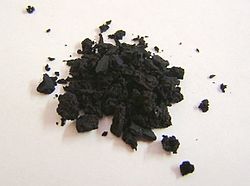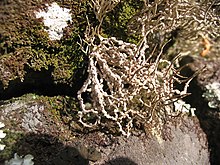litmus
Litmus is a blue-violet dye obtained from certain types of lichen . The aqueous solution has the property of changing its color; depends on whether it is brought into contact with acidic or basic substances (i.e. depending on the pH value ). It is therefore used as an acid-base indicator in chemistry. Litmus is a deep blue mixture of substances with the CAS number 1393-92-6.
Name and story
The name comes from the Indo-European : leg means "tröpfeln" and Mus stands for "porridge" (see also Dutch lakmoes , older lecmoes , from lekken , " tröpfeln " and moes , "porridge"). The name goes back to the historical production of litmus, which was obtained from a pulp of lichen and water that was allowed to drain.
Litmus was first used as a chemical reagent around 1300 by the doctor and alchemist Arnaldus de Villanova ; H. as a substance that is used for the detection and identification of another substance. Since the 16th century the blue dye has been obtained on a larger scale (mainly in the Netherlands as lakmoes ) from various types of lichen. After the secret of the production of litmus from lichens was revealed , the gray-colored lichens Lecanora tartarea and Roccella tinctoria were exported from the Netherlands to other industrialized countries under the names Bergmoos and Klippmoos .
Natural occurrence
Like the related dye orcein, litmus occurs naturally in various types of lichen. Were used for dye extraction in former times usually Roccella tinctoria (growing on rocks Macaronesia ( Cape Verde , Canary Islands , Madeira , Azores ) and the west coast of South America), Roccella fuciformis (origin mostly Angola and Madagascar ), Roccella pygmaea ( Algeria ), Roccella phycopsis , Lecanora tartarea ( Norway , Sweden ), Variolaria dealbata ( Pyrenees and Auvergne ), Ochrolechia parella (entire Atlantic coast of northwestern Europe), Parmotrema tinctorum (also Canary Islands) and various Parmelia species (widespread on many deciduous trees ). The main sources today are Roccella montagnei ( Mozambique ) and Dendrographa leucophoea ( California ).
Manufacturing
For a long time, attempts were made to keep the details of the manufacturing process secret for economic reasons in order to create a monopoly . The powdered lichens are left to stand for several weeks in a solution made alkaline with soda ( sodium carbonate ) or potash ( potassium carbonate ) and ammonia with occasional stirring. Since ammonia was previously not available as a chemical, the necessary amount of ammonia was obtained by adding urine. The urea contained in the urine is converted into ammonia by enzymes acting as catalysts . As the powdered lichens stand in the solution, their color gradually changes from red to blue. The mixture, which is blue at the end of the conversion process, is dried and ground to a powder. In this stage of the manufacturing process, the powder partially containing litmus and partially Orcein - color pigments . With alcohol , the carmine-red part of the color from orcein is removed, leaving behind the deep blue litmus. Pressed and partially mixed with plaster of paris and chalk, it comes on the market as a slightly crumbling molding compound. A special color component - azolitmin - is also produced from litmus and sold as an acid-base indicator with properties similar to litmus.
Today's technical production
In 1758, the two British chemists G. Gordon and Cuthbert Gordon patented the industrial production of cudbear (English name for orcein) and litmus from lichen, but it was not until 1940 before the British company Johnsons of Hendon (later Johnsons Photopia Ltd ) production began.
During production, lichens are first ground, mixed with water with the addition of lime , potash and ammonium carbonate solution ((NH 4 ) 2 CO 3 ) and left to ferment with a supply of air. The solution turns brown and purple to a deep blue after about three weeks. The pulp is stirred through a sieve and mixed with chalk and plaster of paris to form small cubes. After drying, these can be further processed directly; they contain large amounts of orcein and only about 5 to 8% of litmus dyes. The orcein can easily be separated with ethanol due to its good alcohol solubility.
Use and structure

Past and present
Litmus used to be used, especially in the Netherlands, for so-called blueing of laundry and for coloring luxury goods (wines, baked goods, liqueurs, cheese, make-up and sugar paper). The yellowing in the air is compensated for by a slight blue color . Litmus is unsuitable for textile dyeing because of its color changes in acids and alkalis.
Litmus test
Today litmus is used exclusively as an acid-base indicator in chemistry and biology . Litmus appears red at pH values less than 4.5, blue at values greater than 8.3 and purple in between. It is mainly used in two forms: in an aqueous solution as a litmus tincture and as litmus paper . The latter are strips of paper that are soaked in weakly acidic or alkaline litmus tincture (test paper ). The main component of the litmus is polymer (from a plurality of blocks) of 7-hydroxy-2- phenoxazin - chromophores constructed that its relationship with the carmine dye Orcein explained.
Litmus milk
With 2.5 to 7% litmus offset, 10% skimmed milk or skim milk powder and water in a suitable concentration is used in microbiology as Litmus milk . This is used to determine whether bacteria can use milk sugar ( lactose ). To do this, the litmus milk is inoculated with the bacterium. When the color changes from blue (alkaline) to red (acidic) due to acid formation, it has been proven that the bacterium can ferment lactose. The milk is often gelled with agar for better handling .
Structure determination
The German chemist Hans Musso (1925–1988) examined the structure of the lichen dyes orseille , orcein (also cudbear in English ) and litmus dyes between 1955 and 1965 and published about 25 articles on them. Using column chromatographic separation methods , he was able to separate most of the dyes and determine their structure.
Explanation of the indicator effect of litmus
The cause of the color change of the litmus from blue to purple to red when the pH value changes is extremely complex and is composed of various factors:
- The main cause of the color change during the uptake or release of protons ( halochromy ) is the reversible (i.e. reversible) formation of red phenols from blue phenolates .
- Furthermore, the oxazine system (here a cyclic arrangement with opposite oxygen and nitrogen atoms) can be protonated or deprotonated, i.e. That is, protons can attach to the compound or split off again.
- In addition, the tint of the red and blue characteristic colors of litmus changes when strong or weak acids or bases are added to the litmus. This results from the gradual addition or removal of further protons.
Due to the size of the molecule, several phenol groups as well as oxazine nitrogen atoms are available for this addition or release of protons. In addition, mixed systems with a yellow-orange to blue-green color are created in the pH range 5.6 to 8.
Contained substances
The litmus mixture of substances contains around 10-15 different substances. Besides orcein, erythrolein (also erythrolitmin ), azolitmin , spaniolitmin , leucoorcein and leucazolitmin were successfully extracted . Azolitmin as a pure substance has almost the same indicator effect as the mixture.
Orceine
The litmus mixture mainly contains the two orceins α-Hydroxyorcein C 18 H 17 O 5 N and α-Aminoorcein C 18 H 18 O 4 N 2 . These are created (along with more than 10 other orceins) from the coloring matter of the lichens by treatment in an ammonia-containing, alkaline solution with oxidation. During litmus production, most of the orcein is separated off.
Azolite and leucazolite
Azolitmin is the dye that is mainly responsible for the color change with the empirical formula C 18 H 10 O 10 N. It is formed from orceins through oxidation. Leucazolite is a colorless derivative of azolite and can be obtained from this by reduction.
safety instructions
In English-language sources litmus is classified as irritating to (mucous) skin and eyes and as "likely to be flammable at higher temperatures". There are no EU or German guidelines.
See also
literature
- Entry to litmus. In: Römpp Online . Georg Thieme Verlag, accessed on June 13, 2014.
Individual evidence
- ^ Litmus at duden.de, accessed on April 26, 2015.
- ↑ Wissenschaft-Online-Lexika: Entry on litmus in the Lexicon of Medicinal Plants and Drugs , accessed on February 18, 2013.
- ^ Gordon G. and Gordon C: Manufacture of Dye Colors , British patent 727, 1758
- ↑ HHJ Hager, Fv Bruchhausen Hagers Handbook of Pharmaceutical Practice , p. 3, Springer-Verlag , ISBN 3-540-62646-8
- ↑ Microbiological internship for biology and food chemistry , Script SS 2011, TU Munich
- ^ Wissenschaft-Online-Lexika: Entry on litmus milk in the lexicon of biology
- ↑ H. Musso: To Kenntuis the Orseille dyes , Science, 1955, 42, 513
- ↑ H. Musso, C. Rajtjen: About Orceinfarbstoffe: X. light absorption and chromophore of litmus , Chemical Reviews , 1959, 92, 751-753
- ^ H. Musso: The separation of orcein into its components (II. Communication on orcein dyes ), Chemical reports, 1956, 89, 1659-1673
- ^ H. Musso: Orcein and litmus pigments: constitutional elucidation and constitutional proof by synthesis , In: Planta Medica , 1960, 8, 431-446
- ↑ H. Musso, H. Beecken: About orcein dyes. IV. Craig Distribution and Partition Chromatography , Chemical Reports, 1957, 90, 1808-1814
- ↑ What is litmus anyway? , Wiechoczek, D. 1999-2009. In: Blume, R. & Wiechoczek, D. "Professor Blume's Education Server for Chemistry".
- ^ ET Wolf: Complete overview of the elementary-analytical investigations of organic substances, pp. 450–453, published in 1846, Verlag E. Anton
- ^ Lichen purple: Orcein structures
- ↑ Litmus, Powder on Sciencelab ( Memento of the original from September 27, 2007 in the Internet Archive ) Info: The archive link was inserted automatically and has not yet been checked. Please check the original and archive link according to the instructions and then remove this notice. (accessed March 29, 2007)



